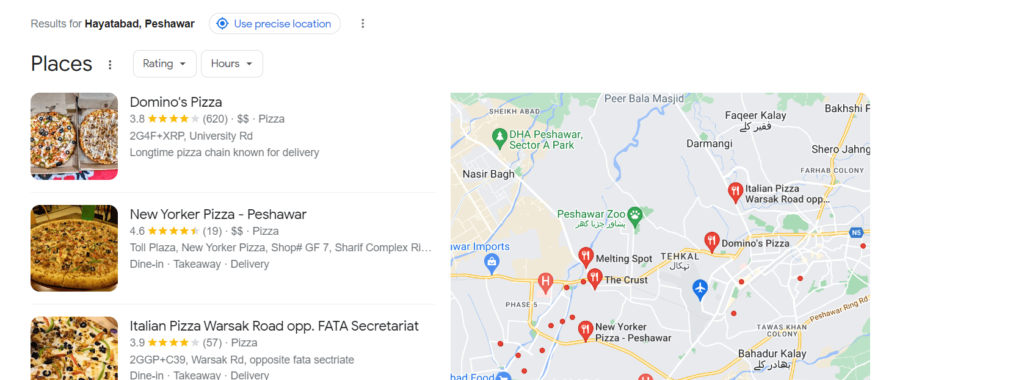Do you know about the concept of Hyperlocal social media marketing? In the world of social media, where a whopping 2.3 billion people are active globally, businesses can’t afford to ignore it. Big companies are already using popular social platforms to reach millions, but local businesses matter too. In the United States alone, there are about 3.8 million shops, making it crucial to connect with local communities.
That’s where hyperlocal social media marketing comes in – a focused strategy to help local businesses attract more customers to their physical stores. It’s about thinking big but acting local. Private social networks like Townsquared and NextDoor, and even Google turning Maps into a social app, show how important local marketing has become.
It is more than just a fancy term; it’s a game-changer for businesses. Imagine this: you’re walking around your neighborhood, and your phone beeps with a message from the local ice cream shop. It’s not just a regular ad; it’s a special offer just for you, like a discount on your favorite flavor. This cool moment happens because of hyperlocal social media marketing, where businesses send personalized messages to people in the area. In a world full of regular ads, local ads are like a friendly tap on your shoulder, offering exactly what you like, right in your backyard.

Now, what makes local marketing different? How does it boost businesses? It’s all about delivering customized content that connects with the local audience. Consider this: 76 percent of users buy something based on what a brand posts on social media, proving its impact on immediate and later purchases, whether in-store or online.
At its core, hyperlocal social media marketing is a focused strategy. It targets a specific local area to promote a business’s products or services. Small businesses often use it to reach customers nearby. It involves creating content that fits the local audience’s interests – from local events and landmarks to showcasing unique products or services in the area. It’s about connecting businesses with their communities at the right time.
What is Hyperlocal Social Media Marketing?
Think of it as having your own friendly local shop in the big world of marketing – it’s small, focused, and all about your community.
This strategy zooms in on a particular place, like your street or neighborhood, with the goal of connecting with potential customers right in your local area.
Imagine you’re a small business owner, running a charming flower shop or a food truck with unique local flavors. Hyperlocal marketing becomes your secret ingredient.
Instead of just advertising, you become part of the everyday conversation in the community by focusing on people in your immediate surroundings.
So, how does it work? It’s all about creating content that fits in with the local scene. Hosting a flower arrangement workshop? Share the excitement. Unveiling a new food truck dish inspired by a local event? Let everyone know. Highlight local landmarks, give a nod to neighboring businesses, and be a voice in local events.

And here’s the interesting part – hyperlocal isn’t only for the smaller businesses. Even big brands can join in, especially when introducing new spots or promoting local gatherings. Picture a well-known chain like “Scoops & Smiles” opening a new ice cream parlor in Austin, TX.
They understood the excitement free ice cream could create, making it a natural choice to offer it at their latest spot. It’s all about nurturing that personal, local vibe – no matter how big or small your business is.
Getting Started with Hyperlocal Social Media Marketing
Getting started with local marketing might seem like a simple task, but it comes with its challenges. Before diving in, it’s crucial to overcome internal hurdles. Here’s a breakdown of steps to kickstart your hyperlocal social media strategy:
Step 1: Assess Your Situation
Engage with the management team to understand their perspective on hyperlocal social marketing. Sometimes, there might be a need to discuss and persuade them about the importance of implementing a hyperlocal marketing strategy. Conduct thorough research to build a compelling case for why a hyperlocal approach is essential.
Step 2: Devise a Plan
Rather than immediately seeking external assistance, explore potential collaboration within your organization. Have conversations with teams like retail and IT to develop a comprehensive plan. Once internal discussions are underway, look for influencers who can execute local influencer marketing campaigns and find technological partners to enhance your strategy.

Step 3: Develop Your Hyperlocal Marketing Strategy
With management approval and a well-thought-out plan in place, it’s time to craft your marketing strategy. Follow these steps:
- Define metrics for success and secure approval from the management team.
- Present your strategy to all relevant stakeholders for input and alignment.
- Choose a technology partner capable of staying abreast of social media platform trends and changes.
Step 4: Train Up
Communicate your plans with local partners and outline their roles in achieving optimal campaign results. Provide training and guidance to ensure everyone is on the same page and equipped to contribute effectively to the hyperlocal marketing initiative.
How to Implement Your Hyperlocal Social Strategy
Implementing a successful strategy involves strategic steps. Here’s a comprehensive breakdown to guide you in implementing your hyperlocal strategy:
Step 1: Choose the Right Social Media Platform
With many options available, pick a platform where your target audience is most active. For many local businesses, Facebook proves to be the go-to platform due to recent enhancements like Graph Search and local awareness ads. While Facebook takes the lead, don’t overlook other major social media platforms that may suit your campaign.
Step 2: Achieve Hyper-Local Scale
Create pages for specific locations to communicate with local people, ensuring your brand’s voice resonates with the local community. Crafting personalized messages for local audiences is challenging but essential. Balance the local touch without losing the core essence of your brand.
Step 3: Clarify Your Marketing Campaign Goals
Clearly define your objectives – whether it’s expanding brand awareness or boosting product sales. If the goal is awareness, promote valuable content to build relationships with existing and potential customers. Engage with your audience through posts to foster a positive image.
For sales-focused campaigns, leverage your established relationships to guide conversations into conversions. Offer product options that address customer needs effectively.

Step 4: Measure and Drive ROI
Assess the success of your marketing by aligning with your defined objectives. Analyze how your target market responds to your messages. If the response aligns with expectations, consider the campaign successful. Measurement methods vary based on your campaign objectives – be it reaching more people, boosting sales, or other defined goals.
Step 5: Use Locally-Driven Paid Media
Leverage locally-driven paid advertising to accelerate sales, especially for Quick Service Restaurants (QSR) and retailers with nearby customer bases. Promote special offers, and discounts or invite locals to events at your stores.
Satisfying customers can lead to recommendations that can help you expand your business.
Step 6: Utilize Locally-Focused Facebook Promotion Methods
Explore local promotion methods on Facebook:
- Local Awareness Ads: Target customers within 1-60 miles of your store to enhance your reach.
- Unpublished Page Posts: For larger brands, maintain a focused local customer experience by promoting unpublished posts directly to local customers without cluttering the main business page.
Who should use Hyperlocal Social Media Marketing?
When it comes to hyperlocal social media marketing, the first question that often arises is, “Who should be using it?” The numbers speak volumes – a whopping 69 percent of digital traffic originates from organic and local searches, with 22 percent attributed specifically to local traffic. If your business isn’t harnessing the potential of hyperlocal social media marketing, you’re missing out on a substantial piece of the digital pie.
Ideal Candidates for Hyperlocal Social Media Marketing:
Brick-and-Mortar Shops: If your business has a physical location, hyperlocal ads can be a game-changer, drawing potential customers right to your doorstep.
Small Businesses: Hyperlocal marketing is tailor-made for small businesses aiming to establish a robust presence in the community. It positions you in front of the people who are most likely to become your loyal customers.
Service Providers in Specific Areas: Whether you’re a plumber or a caterer servicing a particular region, hyperlocal marketing is your ticket to increased visibility.
Businesses for Events or Festivals: Capitalize on the energy of local events or festivals with hyperlocal ads, leading to a surge in sales and visibility during such bustling times.
Your location significantly influences results on social search engines. A quick search for “coffee” on Instagram or any other platform using your phone demonstrates how your location plays a pivotal role.
Benefits of Hyperlocal Social Media Marketing Campaigns:
Creating a Sense of Community and Connection:
Highlighting local landmarks, businesses, events, news, and attractions builds trust and fosters a connection between businesses and the community.
This approach helps businesses establish relationships with other businesses in the community, opening avenues for potential partnerships and collaborations.
Increased Engagement and Interaction with Customers:
Personalized engagement with customers builds trust, and loyalty ultimately drives more sales.
Higher Conversion Rates:
Tailoring content to the interests and needs of local audiences attracts qualified customers, leading to higher conversion rates.

Lower Advertising Costs:
Implementing a hyperlocal marketing strategy involvies targeted audience engagement, local hashtags and geotags, building a referral network, and leveraging user-generated content can effectively lower advertising costs.
In essence, hyperlocal social media marketing isn’t just a buzzword; it’s a strategic approach that can significantly impact businesses of various sizes and types. Whether you’re a coffee shop or a service provider in a specific area, embracing these strategies can elevate your visibility, engagement, and overall success in the digital realm.
How to Develop a Hyperlocal Social Media Marketing Strategy?
A hyperlocal marketing strategy must assess all the angles of your business and should fit them all perfectly. Let’s look into the steps to create a strategy that aligns seamlessly with your objectives.
1. Identify Your Target Audience
Pinpoint where your business can shine the brightest. Whether it’s the energetic city center, a quiet residential district, or a particular city neighborhood, consider where your impact can be most profound. For instance, a boutique might focus on the immediate surroundings, while a mobile pet grooming service could target a broader suburban area.
Key Considerations:
Primary Geographic Focus: Which specific area aligns with your business goals? Is it a particular neighborhood or a larger city zone?
High Engagement Locations: Where has interest in your products or services been most noticeable? Examine past customer data to identify these focal points.
Demographics: What are the age, gender, income level, and other demographic details of your target area? Understanding this helps tailor your message.
Interests and Preferences: Dive into local trends, events, and activities to create content that genuinely resonates with the community.
Competition Landscape: Recognize competitors in your chosen location and strategically target areas near them.
2. Know Your Competition
Understanding your competitors is like having a map in a treasure hunt—it guides you to where you need to go. Explore these methods to comprehend their hyperlocal marketing strategies:
Analyze the Market Landscape:
Identify Main Competitors: Recognize businesses competing for the same audience.
Study Their Strategies: Observe how they market themselves, engage on social media, and run promotions.
Target Their Location: If a competitor is nearby, consider strategically targeting the same area.
Conduct a Thorough Competitor Analysis:
Out-of-Home Advertising: Investigate billboards, signage, and public transport ads for insights into their target audience and marketing strategies.
Social Media Insights: Explore their social media platforms to understand what resonates with their audience.
Promotions and Offers: Analyze the type of promotions they offer to craft compelling offers for your business.
Community Involvement: Check if they participate in events or charity programs to understand their community involvement.
Customer Reviews and Feedback: Gain insights into customer perceptions and preferences through online reviews.
3. Leverage the Gaps
Act on the insights gained from competitor analysis to fill in the gaps and offer something unique. If your competitor lacks a specific service or overlooks a market segment, make it your focal point. For example, if a competitor’s cafe is known for its coffee but not its desserts, introduce a line of delectable, locally-inspired sweets at your place.
4. Create Hyperlocal Content
Crafting content for a specific community is like conversing in the language of your neighborhood. Tailor messages that resonate deeply with the local community, reflecting their everyday experiences, challenges, and joys.
Tailor Your Message:
Localize Your Content: Integrate the name of the area into your copy, mention local events, and highlight neighborhood heroes to make your content more relatable.
Address Needs and Desires: Explore what’s unique about your location—whether it’s a renowned local landmark, a cherished sports team, or a celebrated cultural event. Create content that mirrors these distinctive aspects.
Best Platforms for Hyperlocal Marketing
Selecting the appropriate social media platforms is crucial for businesses aiming to connect with their target audience and accomplish marketing objectives. Hyperlocal social media marketing proves to be a potent strategy for businesses seeking to engage local customers and boost sales, especially when applied on the right platform. Various platforms are available, each offering unique strengths and capabilities. Here are some top choices:
Designed as a business-focused platform, LinkedIn facilitates businesses in reaching other businesses or professionals in specific industries. Community features, including groups and events, provide avenues for businesses to connect with local professionals and enterprises on a deeper level. Active participation in local LinkedIn groups and events enables businesses to interact with customers, fostering relationships that may result in heightened loyalty and increased sales.
Boasting a vast and diverse user base, Facebook simplifies the process for businesses to reach a considerable number of local customers actively using the platform. Community features like groups and events enable businesses to establish deeper connections with the audience. Targeting options, encompassing specific geographic areas and demographics, ensure content reaches the intended audience. Notably, some targeting options may not be accessible when aiming at teens.

With its visually oriented nature, Instagram serves as an ideal platform for presenting products and services in a visually appealing manner. This is particularly effective for businesses in industries such as fashion, beauty, food, and hospitality.
Utilizing hashtags and location tags, businesses can effortlessly target specific geographic areas and audiences. Incorporating location tags enables businesses to connect with local prospects actively searching for businesses in their vicinity. Instagram’s Stories and Reels features offer businesses the opportunity to create brief, captivating, and interactive content, fostering brand awareness and engagement.
Twitter’s expansive user base, real-time dynamics, utilization of hashtags and location tags, advanced search features, advertising platform, and community features position it as a suitable platform for hyperlocal social marketing.
Challenges in Hyperlocal Social Media Marketing
While hyperlocal social media marketing presents a potent tool for businesses, certain challenges must be addressed for successful implementation. Here are key hurdles businesses may encounter:
1. Limited Reach
The very nature of hyperlocal social media restricts its focus to a specific, local geographic area. This implies that businesses may face a challenge in having a limited pool of potential customers to target.
2. Difficulty in Targeting
Despite social media platforms providing targeting options based on location, behavior, and interests, accurately reaching the right audience at the right time for hyperlocal marketing can be challenging. Businesses must thoughtfully consider their target audience, ensuring that their content remains relevant and engaging.
3. Limited Resources
Hyperlocal social media marketing may demand a significant investment of time and resources, particularly for small businesses operating with limited budgets. Tasks such as creating high-quality content, monitoring social media activity, and engaging with customers can become time-consuming endeavors.
4. Competition
In certain markets, businesses may encounter fierce competition from others targeting the same local audience. This heightened competition makes it more challenging for businesses to stand out and attract customers amidst the crowd.
5. Changes to Social Media Algorithms
The dynamic nature of social media algorithms, constantly undergoing changes, poses a challenge for businesses striving to ensure their content reaches the intended audience. Staying current with alterations to social media platforms becomes imperative, requiring businesses to adjust their strategies accordingly.
Conclusion
To sum it all up, hyperlocal social media marketing is like having a powerful friend in the business world—it helps you connect with your community and boosts your local success. But, just like any friend, it brings its own set of challenges.
Picture this: hyperlocal social media focuses on specific local areas, meaning you might not reach a ton of customers. Trying to aim your message at the right people in the ever-changing social media world can be a bit tricky too.
Then there’s the investment of time and resources, which can be a bit much, especially for smaller businesses working with limited budgets. Plus, competing for attention in local markets adds another layer of difficulty, making it important to find ways to stand out.
And don’t forget about those social media rules that keep changing. It’s like a game that keeps shifting, so businesses need to stay alert and tweak their strategies accordingly. Despite these challenges, the potential benefits, like connecting with the community and building strong customer relationships, make it all worthwhile.
So, in a nutshell, the trick is to be smart about it. Businesses can make the most of hyperlocal social media marketing by playing to its strengths while tackling the challenges head-on. With a bit of clever thinking and determination, businesses can unlock the full potential of hyperlocal social media marketing, making meaningful connections and achieving success right in their own neighborhood.
